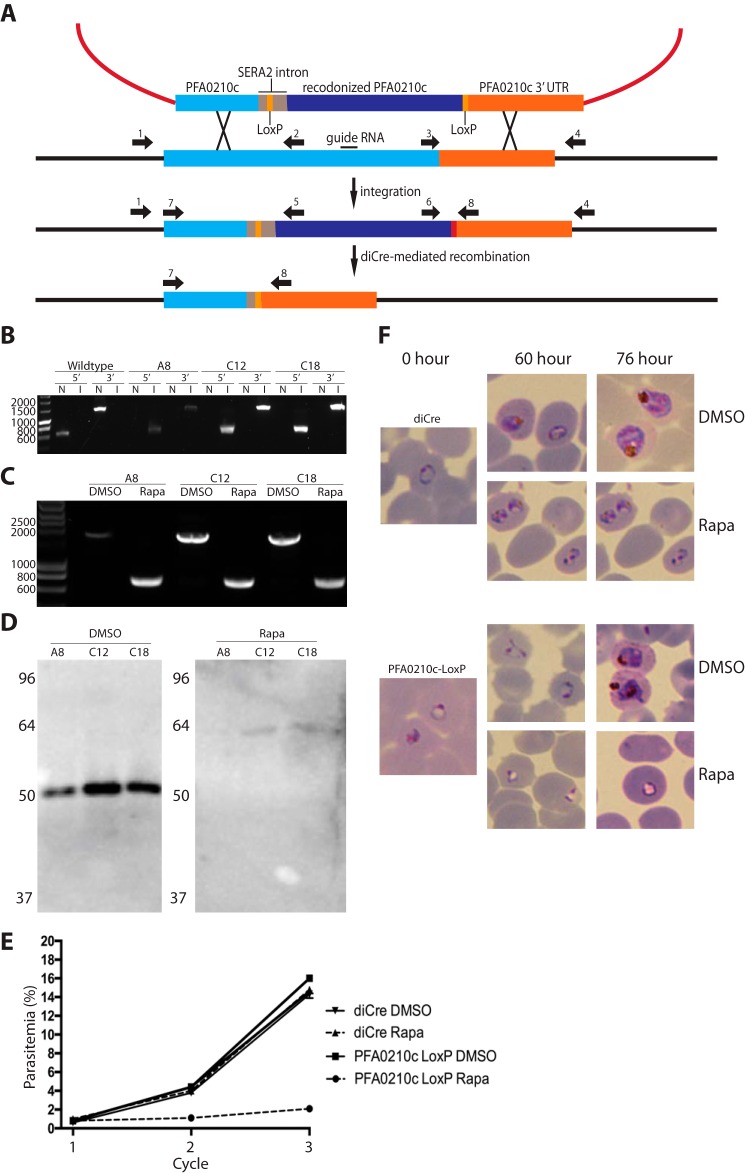FIGURE 4.
Inducible removal of PFA0210c in P. falciparum leads to rapid death of the parasite. A, integration strategy for the replacement of the native PFA0210c locus with a version of the gene containing two loxP sites. Three separate guide RNAs were used to facilitate integration of into the native gene. Induction of Cre recombinase activity by the addition of rapamycin induces the excision of the sequence between the two loxP sites. B, diagnostic PCR of wild type P. falciparum and PFA0210c-LoxP clones A8, C12, and C18 using primers specific for either the native sequence or the integrated re-codonized sequence. Primers used are CVO150 (1) and CVO083 (2) (5′ N), CVO150 and CVO162 (5) (5′ I), CVO071 (3) and CVO183 (4) (3′ N), and CVO321 (6) and CVO183 (3′ I). N indicates primer pair specific for native locus, and I indicates primer pair specific for the integrated PFA0210-LoxP. C, verification of excision after addition of rapamycin in clones A8, C12, and C18. Parasites were treated with 10 nm rapamycin or an equivalent volume of DMSO for 1 h. Forty hours later genomic DNA was extracted and used as template for PCR with primers 7 (CVO001) and 8 (CVO097). Successful excision decreases the size of the expected band from 1536 to 561 bp. D, immunoblot using anti-PFA0210c antibodies shows that rapamycin (Rapa)-treated parasites lack PFA0210c. Parasites were treated early in the ring stage, and proteins were extracted ∼40 h later. E, growth rate of the parasites lacking PFA0210c is severely decreased. Parasites containing PFA0210c-LoxP or the DiCre-expressing parent clone were synchronized in the early ring stage and diluted to a parasitemia of ∼0.6%. The parasites were then treated with 10 nm rapamycin or the equivalent volume of DMSO for 1 h. Parasitemia was measured immediately before treatment (cycle 1), 76 h after diluting (cycle 2), and 96 h after diluting. Parasite cultures were set up in triplicate. Error bars indicate standard deviation. F, parasites lacking PFA0210c form aberrant ring-stage parasites and do not develop past the ring stage. Parasites used in E were used to make Giemsa-stained smears at the times indicated. Parasites from the parent clone appear normal, as do the DMSO-treated PFA0210c-LoxP parasites. PFA0210c-LoxP parasites treated with rapamycin form small rings with vacuolated centers. At the 76-h time point, these parasites have not developed further, in contrast to the parent strain or the DMSO-treated PFA0210c-LoxP strain.

